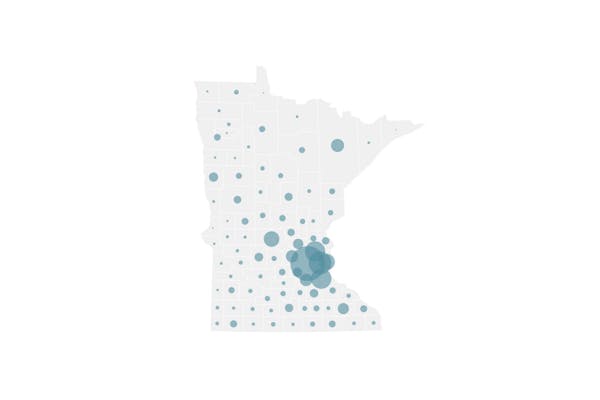One national analyst moved Minnesota into the "making progress" category in its response to the COVID-19 pandemic this weekend, though the state reported another 10 deaths and 361 lab-confirmed cases of the infectious disease on Monday.
The death count was the lowest in two weeks, and the daily case count was the lowest in the state since late April, but whether they reflect a trend is unclear.
The state has reported 1,050 deaths and 25,208 known illnesses associated with COVID-19, a respiratory disease caused by exposure to a novel coronavirus. The number of COVID-19 patients admitted to hospitals stood at 549 on Monday — with 253 of those patients needing intensive care.
Throughout the course of the pandemic, case numbers reported on Monday have tended to be lower than those reported on other days of the week. The state also shut down its public health lab amid the protests, so COVID-19 test results were reported this weekend only from private labs.
Reported progress in Minnesota also preceded a week of protests and riots in Minneapolis and St. Paul following the death of George Floyd while in police custody. Whether so much face-to-face interaction results in a new wave of virus transmission and COVID-19 cases is unclear and won't be known for a week or two because of the delayed onset of symptoms following infection.
Greatest risks of severe COVID-19 remained with the elderly and people with underlying health conditions, including diabetes, asthma and diseases of the heart, lungs, kidneys and the immune system. Among all deaths, 855 involved residents of long-term care facilities.
As many as 80% of infections with the novel coronavirus result in mild or no symptoms, which adds to concerns that protesters could be carrying the virus and spreading it to others without knowing it.
Young people haven't suffered as many severe cases — as people 30 and younger represent 47% of the lab-confirmed cases in Minnesota but only six total deaths.
Transmission of the virus among predominantly younger protesters could have a broader impact, though. Rates of severe cases have been higher among black people in Minnesota, who make up more than 20% of the state's COVID-19 hospitalizations but only 6% of the state population.
Health officials in late May noted how an outbreak among a largely black Cedar-Riverside community of Minneapolis could be traced in part to the number of people carrying the virus back from the long-term care facilities in which they worked.
Any sign of the pandemic easing is nonetheless good news. State health officials had been closely watching case counts following the end of a 51-day stay-at-home order on May 18, because of concerns that increased business and retail activity could increase disease transmission.
Additional restrictions were eased Monday, with restaurants and bars being able to provide outdoor service, and salons being able to offer limited appointments with mask wearing required.
The national Covid Exit Strategy website had recently upgraded Minnesota from "doing poorly" to "making progress" against COVID-19 based on its average daily case count declining over the past two weeks.
Jeremy Olson • 612-673-7744

Baseball Metro Player of the Year packs up his five tools and leaves

Prep baseball 2024: 35 Minnesota stars who the recruiters covet
Police searching for St. Paul home intruder who raped, robbed woman

Friend heard money, relationship woes from man tied to Chanhassen killing who took his own life

